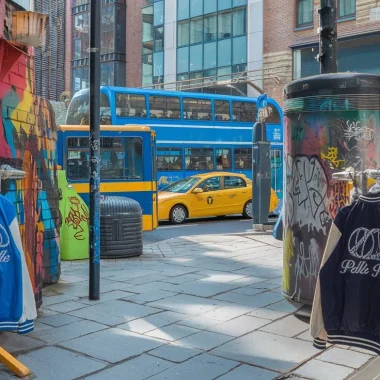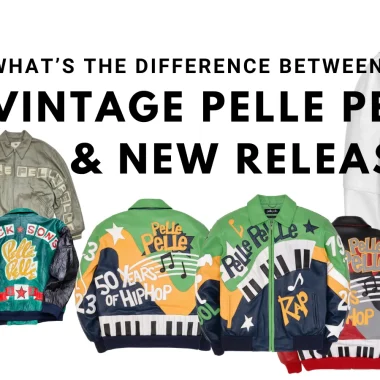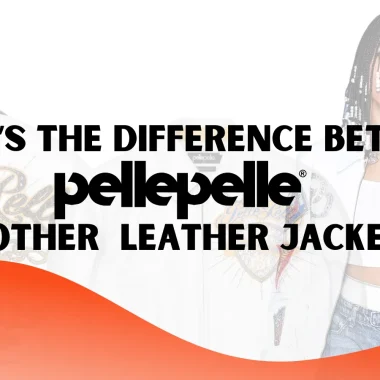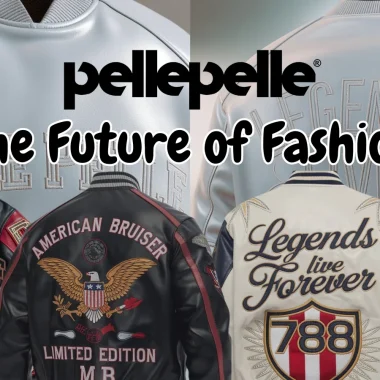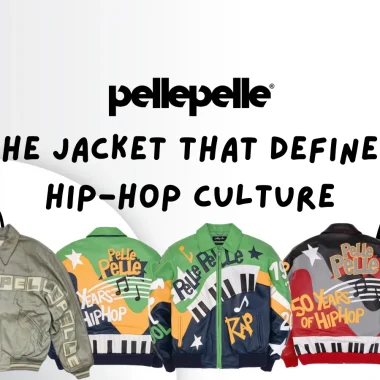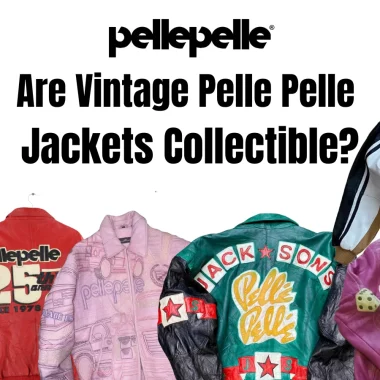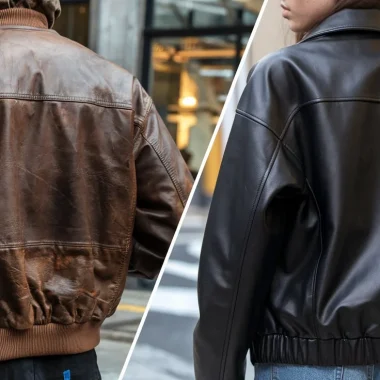From Stardom to Silence: The Untold Story of Pelle Pelle's Demise
The question many ask is, why did Pelle Pelle go out of business? By 2018, Pelle Pelle had quietly exited the market with little to no explanation. But now, Buchanan has finally revealed that the brand’s sudden disappearance was due to the challenges he faced when many of the small specialty stores he worked with began closing.
Some suggest it was a well-deserved break after a long and successful career. Others posit a lack of strategic direction or difficulty navigating the changing fashion scene might have played a role. Without any official communication, the reasons behind Buchanan’s exit and the brand’s subsequent closure remain a mystery.
Why Did Pelle Pelle Go Out of Business? The Birth of a Brand
What caused Pelle Pelle to shut down? Despite its initial success, various challenges emerged over the years. Tired of the limited options available, Buchanan saw a gap in the market for clothing that reflected the energy and vibrancy of hip-hop culture. This vision led to the birth of Pelle Pelle, a brand that would become a cornerstone of hip-hop fashion.
Buchanan’s ability in leatherwork, coupled with his keen eye for design, resulted in high-quality leather jackets adorned with intricate details and bold colors. These weren’t just jackets; they were statement pieces – a way for young people, particularly African Americans and Latinos, to express themselves through fashion.
“I have a lot of people asking me to bring the line back. It’s very tempting and I will eventually do it.”
Marc Buchanan

Why Did Pelle Pelle Go Out of Business? Embraced by Hip-Hop Royalty
How did hip-hop culture contribute to Pelle Pelle’s initial success? The endorsements from prominent hip-hop figures played a crucial role. Pelle Pelle’s success stemmed from several key factors. Firstly, it offered a distinct alternative to mainstream clothing, catering specifically to the emerging hip-hop aesthetic. Secondly, the brand received crucial endorsements from prominent hip-hop figures. Legendary artists like LL Cool J, Run-DMC, and Big Daddy Kane were often seen sporting Pelle Pelle jackets, solidifying the brand’s association with hip-hop culture.
These early endorsements fueled a wave of popularity. Pelle Pelle jackets became coveted status symbols, referenced in rap lyrics and music videos. The brand wasn’t just clothing; it was a symbol of identity and belonging within the burgeoning hip-hop community.
Why Did Pelle Pelle Go Out of Business? A Shift in Trends
However, the fashion world is in constant flux, and by the late 1990s and early 2000s, signs of Pelle Pelle’s decline began to appear. Hip-hop fashion evolved, embracing a more casual and athletic aesthetic. Contemporary brands like Fubu and Rocawear rose to prominence, offering baggy clothing and streetwear that resonated with a new generation. Pelle Pelle was founded by Marc Buchanan in 1978. The brand quickly gained popularity for its unique and bold designs, particularly its leather jackets adorned with intricate embroidery and embellishments. But why did Pelle Pelle close down? To understand this, we need to delve into the factors that led to its decline.
Fubu, for example, capitalized on the popularity of baggy jeans and oversized t-shirts, incorporating elements of basketball culture into their designs. Rocawear, founded by rapper Jay-Z, offered a more upscale take on streetwear, featuring premium materials and a strong focus on branding.
Pelle Pelle, with its focus on brightly colored leather jackets, might have seemed dated in comparison. While they introduced some modern designs, they largely stuck to their core aesthetic, potentially missing opportunities to update their collections and cater to a broader audience. Pelle Pelle was founded by Marc Buchanan in 1978. The brand quickly gained popularity for its unique and bold designs, particularly its leather jackets adorned with intricate embroidery and embellishments.
The Rise of Athleisure and a Missed Opportunity
Another significant factor in Pelle Pelle’s decline was the rise of athleisure. Athletic wear, once relegated to the gym, began to be incorporated into everyday clothing. Brands like Nike and Adidas capitalized on this trend, offering comfortable and stylish clothing that blurred the lines between sportswear and casual wear. Pelle Pelle, with its focus on traditional leather jackets, wasn’t well-positioned to compete in this new market.
Marketing and Business Decisions: Did Pelle Pelle Falter?
Why did Pelle Pelle stop operating? Examining the impact of their business strategies, including their online retail presence and social media engagement, may provide insights. While the exact reasons behind Pelle Pelle’s decline remain unclear, it’s worth exploring potential marketing or business decisions that might have contributed to its struggles. Here are some areas to consider:
- Online Retail Presence: Did Pelle Pelle struggle to adapt to the rise of online retail? As online shopping gained traction, a user-friendly website and strong online presence became crucial. Competitors like Fubu and Rocawear embraced online sales early on, reaching a wider global audience.
- Social Media Engagement: Social media platforms like Instagram and Twitter became increasingly important marketing tools. Did Pelle Pelle use these platforms to connect with fans and highlight their products? A strong social media presence could have helped them stay relevant and engage with a new generation of consumers.
- Distribution Channels: Did Pelle Pelle rely solely on traditional department stores and independent retailers? As the fashion landscape changed, might they have received help from exploring partnerships with streetwear or athletic wear stores? Partnering with stores catering to a younger clientele could have helped Pelle Pelle reach a new audience.
Founder’s Exit and the Uncertain Future
Did Pelle Pelle’s closure relate to Marc Buchanan’s retirement? His exit coincided with the brand’s decline. Adding to the mystery surrounding Pelle Pelle’s fate was the news of Marc Buchanan’s clear retirement from the fashion industry around 2019. With the brand’s driving force seemingly stepping away, Pelle Pelle’s operations ceased. There’s no official confirmation about Buchanan’s decision. Some guess it was a well-deserved retirement after a long and successful career.
The year is 1978. The burgeoning hip-hop scene pulsates with energy, demanding a fashion language that reflects its vibrant spirit. Enter Marc Buchanan, a Detroit designer tired of the limitations of mainstream clothing. Inspired by the energy of the streets and fueled by his expertise in leatherwork, Buchanan embarks on a mission – to create clothing that embodies the soul of hip-hop.
His basement becomes a workshop, the rhythmic clatter of sewing machines the soundtrack to his vision. From this humble beginning emerges Pelle Pelle, a brand destined to become synonymous with bold colors, luxurious leather, and a deep connection to hip-hop culture.
However, others posit that a lack of strategic direction or difficulty navigating the changing fashion scene might have played a role. Without a clear explanation, the reasons behind Buchanan’s departure remain shrouded in speculation.
A Glimmer of Hope: A Potential Comeback?
The fashion world, like the music it often reflects, is in constant flux. By the late 1990s and early 2000s, a new aesthetic began to dominate hip-hop fashion: athleisure. Brands like Fubu and Rocawear offered a more casual, athletic-inspired look that resonated with a new generation.
Pelle Pelle, with its focus on brightly colored leather jackets, might have seemed dated in comparison. While they introduced some new designs, they largely stuck to their core aesthetic, potentially missing out on opportunities to update their collections and cater to a broader audience.
The rise of online retail presented another challenge. While competitors like Fubu and Rocawear embraced the digital age, Pelle Pelle’s online presence remained limited. This could have alienated a generation increasingly accustomed to online shopping.
Despite the closure, there have been hints of a possible Pelle Pelle revival. The brand’s European license is currently held by Too Shy, a Danish company. While the details remain unclear, this suggests an interest in keeping the Pelle Pelle name alive.
Here are some potential scenarios for a Pelle Pelle comeback:
- Interviews with hip-hop legends: Conversations with pioneers like LL Cool J or Run-DMC members, discussing their early experiences with Pelle Pelle and its influence on the culture.
- Behind-the-scenes glimpses: Showcasing the design process under Marc Buchanan’s leadership, highlighting the craftsmanship and dedication that went into each piece.
- User-generated content: Encouraging fans to share their Pelle Pelle stories and photos, fostering a sense of community and nostalgia.
- Reintroduction of Classic Designs: The brand could leverage nostalgia by reintroducing classic designs to a new generation of hip-hop enthusiasts. A carefully curated collection of iconic jackets, perhaps with updated materials and sizing, could resonate with fans who remember Pelle Pelle’s golden age.
- Modernization and Collaboration: Pelle Pelle could try a more significant reinvention, adapting its core design philosophy to contemporary fashion trends. Collaborations with established streetwear designers or rising stars could breathe new life into the brand, attracting a wider audience.
- Strategic Marketing and Social Media Presence: A successful revival would require a strong marketing strategy. Leveraging social media platforms like Instagram and TikTok could be crucial to reach a younger generation. Engaging with influencers and content creators within the hip-hop community could create a buzz and generate excitement for the brand’s return.
The Power of Nostalgia: Can Pelle Pelle Reclaim its Throne?
The success of any revival hinges on understanding the current fashion landscape. Can Pelle Pelle bridge the gap between its legacy and the preferences of modern consumers? Will the brand resonate with a new generation raised on athleisure and streetwear?
The answer lies in the power of nostalgia. A well-executed comeback campaign could capitalize on the brand’s rich history and cultural significance. Pelle Pelle doesn’t need to abandon its core identity, but it might need to adapt and evolve to find its place in the ever-changing world of fashion.
Examining the Landscape: Competitors and Collaborations
Looking at the current streetwear landscape, potential collaborators for a Pelle Pelle revival could include:
- Off-White: This high-end streetwear brand, founded by the late Virgil Abloh, is known for its bold designs and high-quality materials. A collaboration between Pelle Pelle and Off-White could create a limited-edition collection that bridges the gap between luxury and streetwear.
- A Bathing Ape (Bape): This Japanese streetwear brand is known for its playful and often loud designs. A collaboration between Pelle Pelle and Bape could result in a collection that injects Pelle Pelle’s classic style with a contemporary twist.
- Supreme: This highly sought-after streetwear brand is known for its limited-edition releases and collaborations. A SUPREME x Pelle Pelle collection would likely generate significant hype and excitement, potentially introducing Pelle Pelle to a whole new generation of consumers.
Challenges and Opportunities: Can Pelle Pelle Overcome the Odds?
A Pelle Pelle revival wouldn’t be without its challenges. The brand needs to compete with established streetwear giants and navigate a saturated market. Additionally, ensuring quality and keeping a premium image will be crucial to avoid being seen as a cheap knock-off.
However, there are also significant opportunities. Nostalgia for 90s fashion is strong, and Pelle Pelle’s rich history could be a powerful marketing tool. Additionally, the brand has the potential to carve out a niche within the streetwear market, offering a unique blend of classic style and modern innovation.
Conclusion: A Legacy Waiting to be Redefined
Pelle Pelle’s story is an intriguing example of a brand that rose to prominence within a specific cultural context. While its future is uncertain, the brand’s influence on hip-hop fashion stays undeniable. Whether Pelle Pelle re-emerges as a nostalgic throwback or a reinvented force in the industry, its legacy as a symbol of hip-hop identity is secure.
The Power of Nostalgia: Can Pelle Pelle Reclaim its Throne?
The success of any revival hinges on understanding the current fashion landscape. Can Pelle Pelle bridge the gap between its legacy and the preferences of modern consumers? Will the brand resonate with a new generation raised on athleisure and streetwear?
The answer lies in the power of nostalgia. A well-executed comeback campaign could capitalize on the brand’s rich history and cultural significance. Pelle Pelle doesn’t need to abandon its core identity, but it might need to adapt and evolve to find its place in the ever-changing world of fashion.
Examining the Landscape: Competitors and Collaborations
Looking at the current streetwear landscape, potential collaborators for a Pelle Pelle revival could include:
- Off-White: This high-end streetwear brand, founded by the late Virgil Abloh, is known for its bold designs and high-quality materials. A collaboration between Pelle Pelle and Off-White could create a limited-edition collection that bridges the gap between luxury and streetwear.
- A Bathing Ape (Bape): This Japanese streetwear brand is known for its playful and often loud designs. A collaboration between Pelle Pelle and Bape could result in a collection that injects Pelle Pelle’s classic style with a contemporary twist.
- Supreme: This highly sought-after streetwear brand is known for its limited-edition releases and collaborations. A SUPREME x Pelle Pelle collection would likely generate significant hype and excitement, potentially introducing Pelle Pelle to a whole new generation of consumers.
Looking Forward: Will Pelle Pelle Rise Again?
The potential return of Pelle Pelle presents a fascinating case study in brand revival. Here are some added factors to consider:
- The Rise of Sustainable Fashion: Consumers are increasingly concerned about the environmental impact of the clothing they wear. A Pelle Pelle comeback could emphasize sustainable practices, using ethically sourced materials and eco-friendly production methods. This would resonate with a growing segment of the fashion market and align with the values of many younger consumers.
- The Power of Storytelling: A successful revival hinges on effectively communicating the brand’s story. Highlighting Pelle Pelle’s rich history and cultural significance can create a deeper connection with consumers. Social media campaigns could feature interviews with hip-hop legends who wore Pelle Pelle in their early careers, or behind-the-scenes glimpses into the design process.
- Transparency and Community Building: Open communication with fans and potential customers is crucial. Utilizing social media platforms to engage in conversations, answer questions, and build a community around the brand can foster loyalty and excitement.
Potential Hurdles: Can Pelle Pelle Avoid the Pitfalls?
Before wrapping up, What led to the closure of Pelle Pelle? Understanding the various factors, from market trends to business decisions, is key to comprehending the brand’s journey.”
While the prospects for a revival are promising, there are potential hurdles to overcome:
- Maintaining Quality: Pelle Pelle built its reputation on high-quality leather jackets. In a competitive market with many price points, keeping this quality will be essential to avoid alienating customers seeking premium products.
- Avoiding Exploitation of Nostalgia: Relying solely on nostalgia can be a dangerous strategy. Consumers crave authenticity, and a revival that feels like a cheap cash grab is unlikely to succeed. Pelle Pelle needs to find a way to honor its legacy while offering something new and exciting for the present.
- Standing Out in a Crowded Market: The streetwear market is fiercely competitive. Pelle Pelle needs to clearly define its niche and differentiate itself from established brands. Collaboration with innovative designers and a focus on unique design elements can help the brand carve out a distinct space.
The Final Word: A Brand with a Future?
Pelle Pelle’s future stays unwritten. Yet, the brand’s potential for a successful comeback is undeniable. With a well-crafted strategy, a focus on quality and innovation, and a commitment to connecting with a new generation, Pelle Pelle could reclaim its place as a leader in hip-hop fashion.
Whether the brand chooses to capitalize on nostalgia or forge a new path, its legacy within hip-hop culture still is secure. Pelle Pelle’s story serves as a reminder of the power of fashion to express identity and the ever-evolving nature of trends. As the fashion world continues to turn, only time will tell if Pelle Pelle can rise again and rewrite its own future.
Pelle Pelle’s future remains unwritten. Yet, the brand’s potential for a successful comeback is undeniable:
- A Well-Crafted Strategy: A clear vision for the brand’s identity, target audience, and marketing approach is essential.
- Focus on Quality and Innovation: Maintaining premium materials and introducing exciting new designs is key.
- Connecting with a New Generation: Utilizing social media and collaborating with relevant figures can establish Pelle Pelle’s relevance today.
Whether the brand chooses to capitalize on nostalgia or forge a new path, its legacy within hip-hop culture remains secure:
- A Pioneering Force: Pelle Pelle popularized the bold leather jacket aesthetic within hip-hop, influencing countless brands.
- Symbol of Identity: For many, owning a Pelle Pelle jacket wasn’t just about fashion; it was about belonging and expressing identity.
- A Cultural Touchstone: Pelle Pelle transcended clothing, becoming a symbol of a specific era in hip-hop history, embedded in music videos, lyrics, and pop culture.
In summary, understanding why did Pelle Pelle go out of business requires looking at various factors.



